
Table of Contents:
– Background
– Look and Feel
– Reticle
– Comparative Optical Evaluation
– Mechanical Testing
– Summary and Conclusion
– Your Pro and Con Breakdown:
– Testing Methodology
Background:
As a rule, you don’t get what you ask for. What I mean is that in the course of interviewing industry people and talking about this or that product, I often find myself saying, if only product X were made with Y and Z features. Such as, “Boy, if I could just have an SIII 6-24x50mm optical platform in front focal plane with 10mil per turn turrets and a zero stop!”. Typically, the product never happens. I’ve been waiting years for a Berger .224 Hybrid (not VLD – I can never get them to consistently behave) bullet between 70 and 77grs for instance. In the case of the SIII with all the bells and whistles though, here it is, exactly as I asked for!
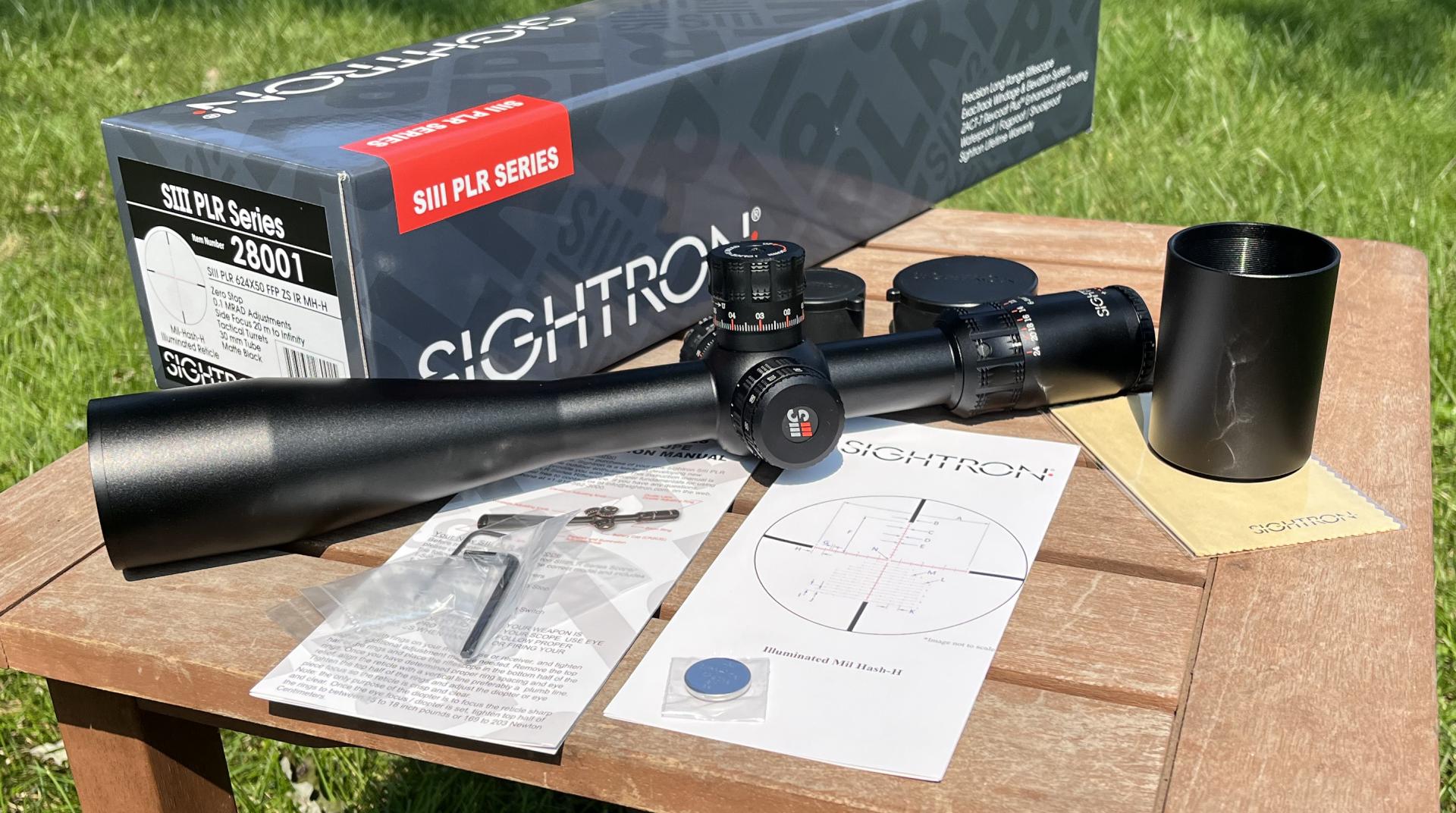
For those unfamiliar with Sightron, it is a small division of a very large and diversified optics manufacturer headquartered in Japan. As is often the case with such companies, the main focus of the company is not on the small sport optics division. This is the reason why it took so long for them to begin offering the FFP, mil / mil, zero stop configurations now dominating the industry. While these trends are obvious to those in the precision shooting world here in the U.S., they were not so to the upper management of Japanese or European diversified optics companies. I have been banging my head against this wall at a lot of companies for a long time. Manufacturing expertise is high at Sightron, though, and now you can buy an SIII 6-24×50 with the right features for long range shooting.
Look and Feel:
For the PLR version of the SIII line, Sightron decided on a pretty radical departure from its other products. The PLR line has a rather bold red and white color scheme whose font and look somehow remind me of the boom time of 1990s Japanese electronics. The atypical Knurling pattern somehow also fits with this as does the font and styling Sightron has always used on their logo. The new white graduation markings are also a great deal more visible than the previous gold markings were. I dig the overall effect. Might look particularly good on a red and black chassis, or maybe on that carbon laden MDT HNT26.
In the box with the scope, Sightron includes a short manual fold out with warranty info on the back. For its length, it’s not bad, and the warranty is of the limited lifetime variety. In addition to the manual fold-out, there is a reticle diagram fold-out with dimensioned reticle drawing. Much appreciated! For those interested, a scan is included in the reticle section of this review. The extras included with the SIII PLR are flip up caps, a sunshade, and a lens cloth. This is a slight change from the previous SIII, which included a Scopecoat instead of the caps. Either way, it’s a nice package and more than you typically get at this price point.
Physically, the SIII PLR, like its predecessor SIII models, is small and light. Its 50mm objective is a good deal smaller than the scopes it most competes with and, at 28oz, it is a good deal lighter than most, though not quite as light as its predecessor. The SIIISS624x50LRFFP/MH was 23.8oz. As the two share an optical design, the extra weight can be attributed to the upgraded turrets and addition of illumination. As with the previous design, the PLR can focus very close- 20 meters – for rimfire use.
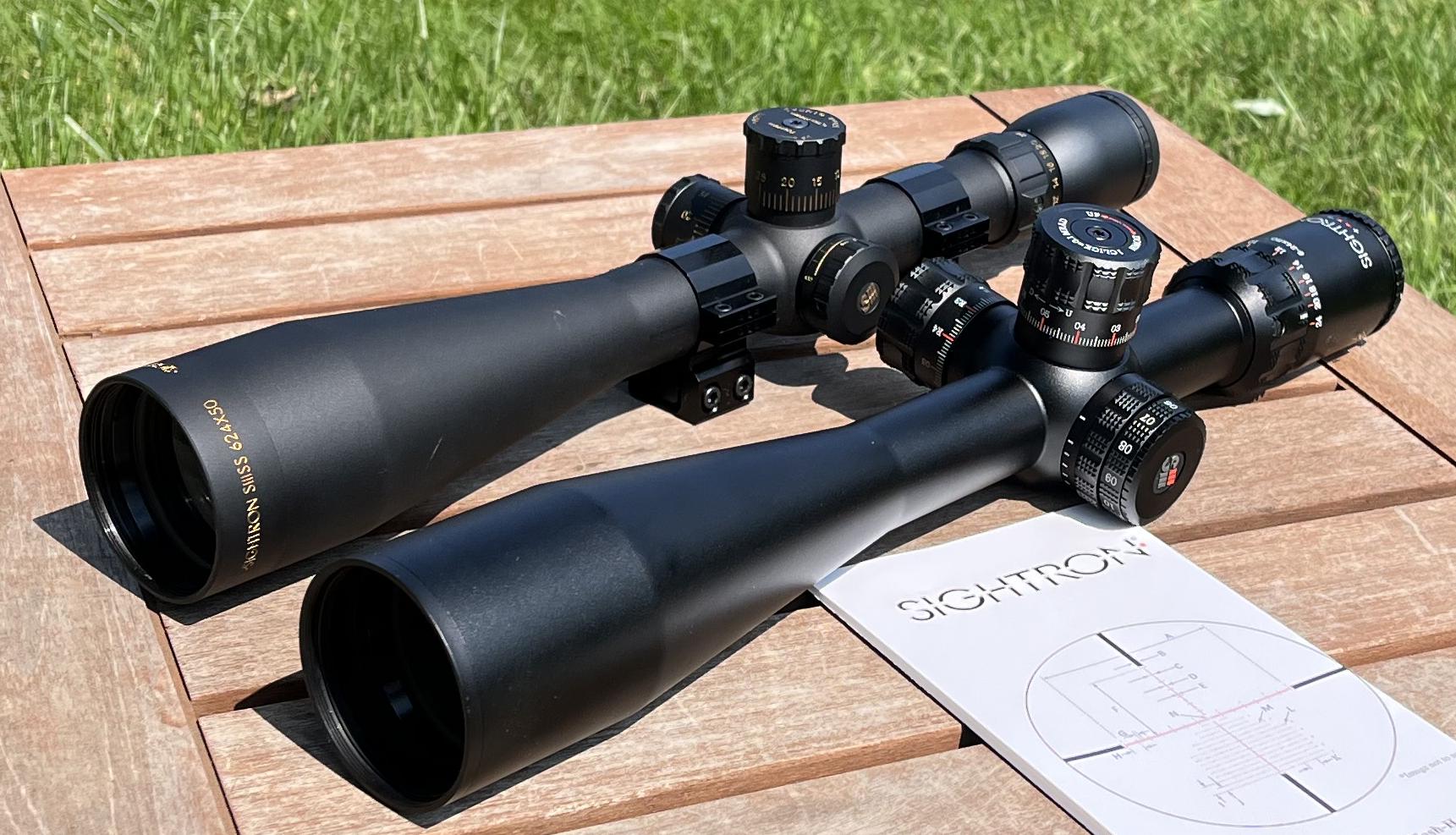
Speaking of those turrets, certainly the biggest deal with the PLR is the addition of 10mil per turn turrets with zero stop. (There is also an MOA version for those in the dark ages.) The zero stop is of the now near ubiquitous collar style design. These have become so common because they are cheap to make, quite robust, and offer the additional benefit of allowing the user a choice of how much travel below the zero to choose before the stop. As with other designs featuring a zero stop of this type, the PLR has translating turrets. This means the external knob goes up and down when adjusted and the rev is therefore read off of the post itself instead of having a pop-up indicator. Different than most other designs, however, is the single torx top screw Sightron uses. This minimizes the chance of stripping tiny set screws but makes it a little touchier getting the zero perfectly aligned. The outer sleeve of the knob on Sightron’s adjustments is not keyed to the inner post, so be aware it can slip if not tightened properly. Internally, Sightron also uses just one set screw on the stop collar instead of three. Be careful not to over torque this, as it is just one little set screw and threaded into aluminum.
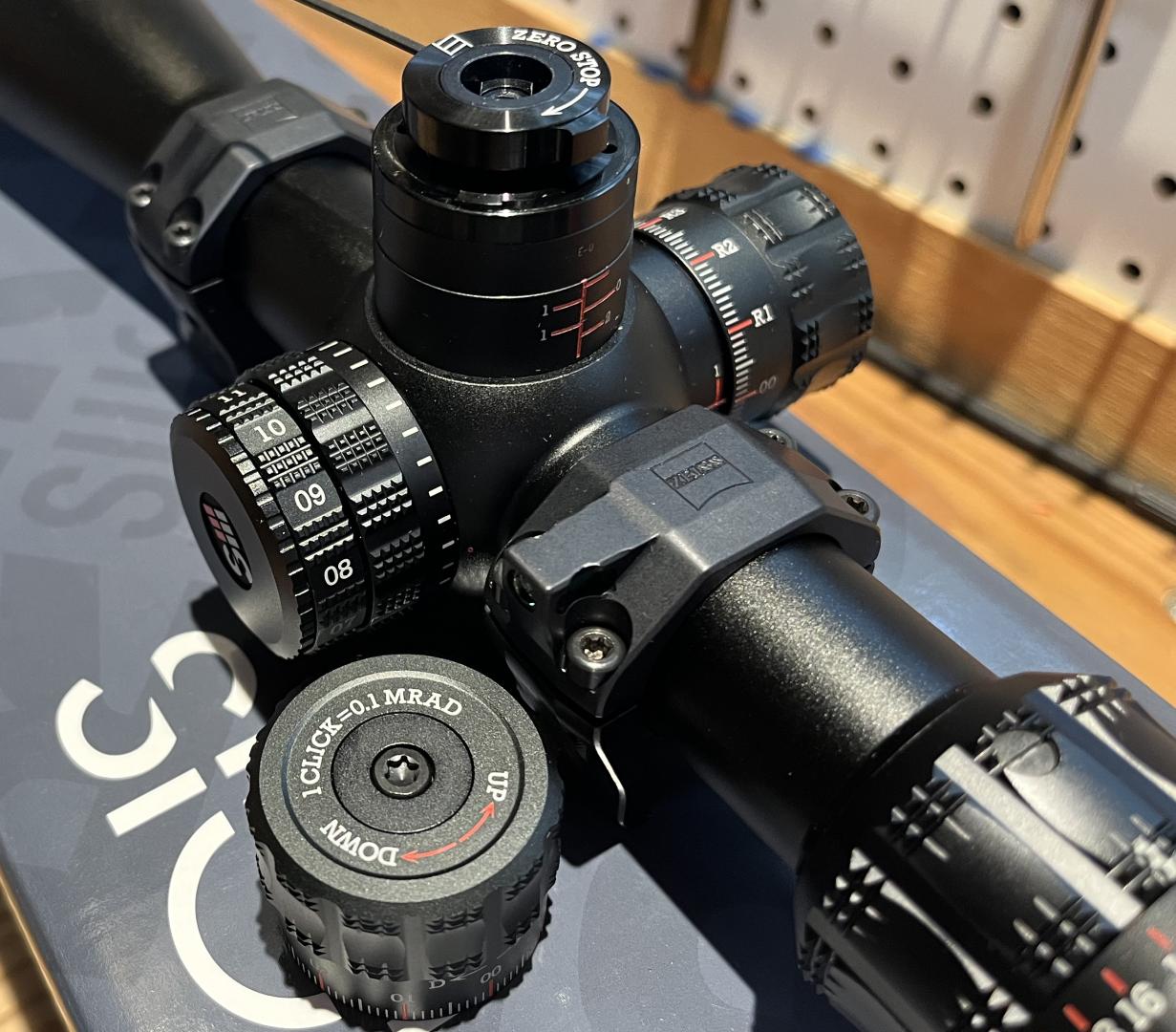
As for the feel of the new turrets on the PLR SIII, wow, it is good. Sightron must have really spent some time on this. The clicks are well defined and quite tactile as well as audible, all while feeling smooth. The adjustments move with a good ratio of resistance between the click stiffness and the background resistance of the knob such that you have no trouble moving just a single click at a time, but it doesn’t feel mushy. The overall force required to move the adjustments is a little on the lighter side, but that is the only thing not totally perfect about the feel of these adjustments. They are very good. Sightron did a great job. These feel better than most scopes twice its cost. As for the other adjustments, the diopter, parallax, and illumination are perfect. The power ring is a little on the stiff side. No doubt some folks will buy a throw lever for it.
Reticle:
The Sightron SIII PLR FFP 6-24×50 ZS comes in two reticles: the mil one, MH-H IR is coupled with mil turrets, and the MOA one, the MOA-H IR, is coupled with MOA turrets. Both of these are Christmas tree style reticles. My review sample features the mil graduated HM-H IR reticle and that is what I will speak further on.
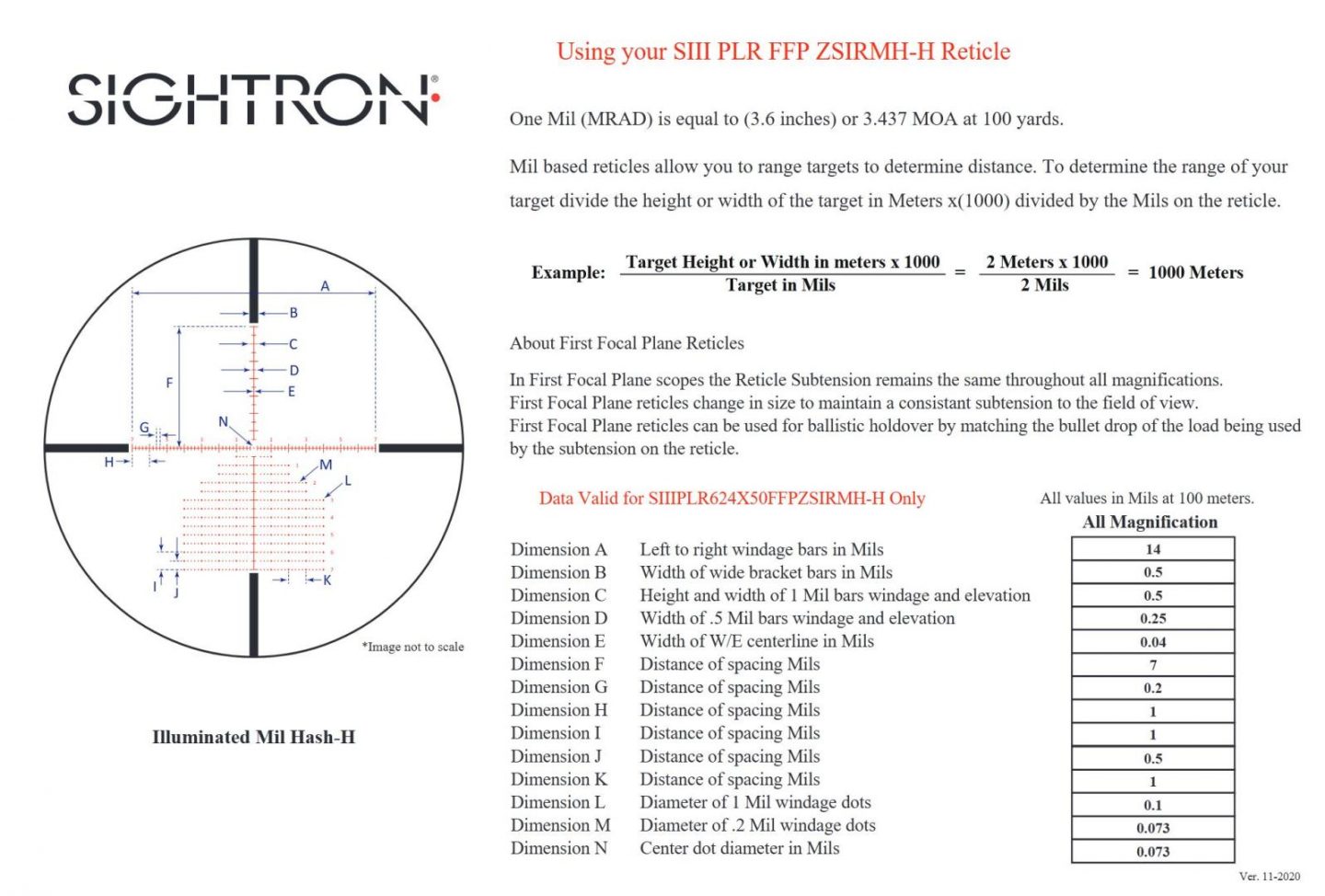
As you can see, the MH-H IR reticle is similar to most .2mil graduated mil reticles out there. It has the floating dot center and .2mil graduations on the horizontal you’re used to. It’s also quite nicely labeled every 2 mils on the horizontal and every mil on the vertical. For some reason, the vertical axis switches from .2mil graduations to half mil ones. This is unfortunate, as I think having to switch mental modes midstream isn’t great. I’ve tried a variety of reticles in each camp and I feel slower and always have to double check myself on those that are mixed. The Christmas tree is also rather busy on the MH-H reticle, with .2mil graduated branches every half mil going down. I would classify the line thickness on the reticle as medium. It neither has caterpillar lines nor spider webs.
All in all the MH-H IR is a serviceable reticle. I wouldn’t call it a finely polished gem, but it’s not an ill-conceived train wreck either. Sort of a mediocre one-size-fits-all solution.
In testing, the reticle dimensions tested 100% correct, though it was canted clockwise relative to the adjustments 1.03 degrees or .18mils in 10mils of elevation travel. This is more than they should allow. Typically, I see .5 degrees or less across cant with the many scopes I have tested. Sightron should tighten up the QC requirement on this aspect of production. Deviating almost 2 clicks on a 10mil drop shot is a lot. To compensate, I trued the bubble level on the rings I’m using to the adjustments instead of the reticle. This is a procedure requiring more equipment than most shooters have at their disposal and has the downside of trading windage error added with drop for drop error added with wind (assuming you dial drop and hold wind). I’m in Ohio, though, so lots of trees and not much wind.
Comparative Optical Evaluation:
As mentioned before, the optical design in the SIII PLR FFP is the same as was used in the SIIISS624x50LRFFP/MH I reviewed a few years ago while I was doing a series of reviews on ~$1k scopes. This design is a first focal plane adaptation of a design Sightron has used in second focal plane scopes for years. The design was, in fact, originally made with 2fp f-class competition in mind, and it has been popular for years in this application. Taking another look at this design this year has been interesting as I have had a full several years now to evaluate it. Also, in the intervening years, I did a series of reviews on ~$2k scopes, providing me a great many more scopes to compare the PLR to. I have, in fact, found myself comparing the SIII PLR more to the ~$2k scopes than to those in the ~$1k price range.
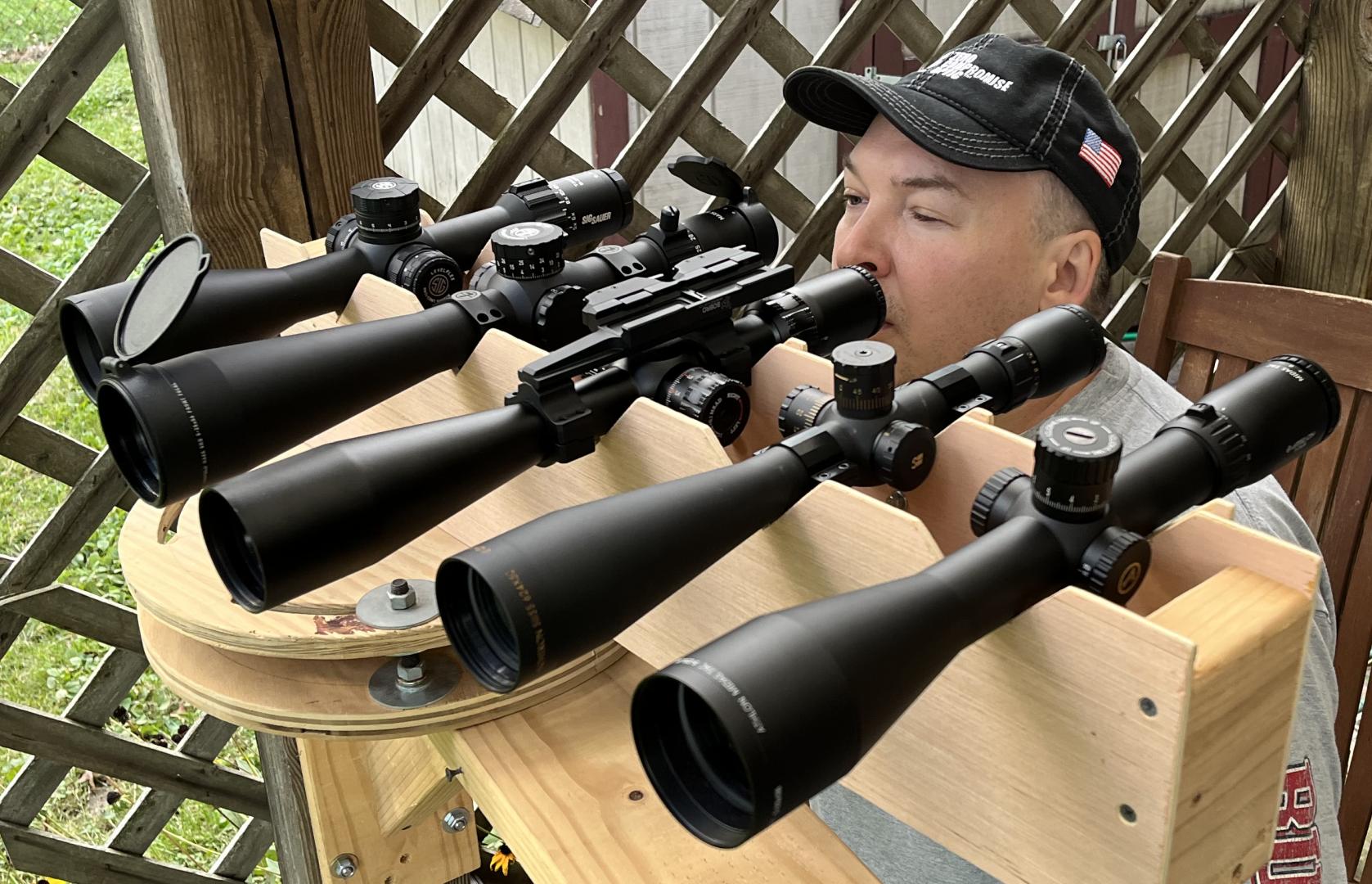
I think the most interesting aspect of the SIII PLR FFP’s performance is the optical design’s origin as an F-class scope. This shows big time in both its strengths and weaknesses. One of the highpoints of the PLR’s optical performance is its resolution. It is super sharp – a hairs breadth from the ~$2k scopes and significantly better than any of the other scopes in the ~$1k range. Another high point is its stray light handling. Even without the supplied sunshade, it has no problems getting cloudy or blooming when it gets a little direct sun on its objective. This is probably the primary factor in it being just so darn comfortable to be behind in every condition. Chromatic aberration in this design is also good. Not Leupold good, but a little better than the Sig Tango6 and a good deal better than the ~$1k scopes generally were. These aspects of optical performance matter to F-class shooters and the PLR performs.

On the other side of the performance spectrum, F-class shooters don’t care about field of view or depth of field, and the PLR doesn’t either. Its FOV on 24x is smaller than most of the comparison scopes at 25x and its depth of field performance was dead last. This will hurt it in practical rifle competitive use where a larger FoV is quite helpful in quick target acquisition and time constraints sometimes do not allow for adjustment of parallax on each target. Of course, its 6-24x multiplier is also only an erector ratio of 4x when most other scopes are 5 or 6x. This matters little to F-class shooters and, frankly, shouldn’t matter a whole lot to anybody else either, when not dealing with 1-n(x) LPVO combat optics. Erector ratio is nice, but really not worth giving up much optical performance for. More FOV and DOF are missed in timed competition use, however.
Other aspects of the PLR FFP’s optical performance were a bit more of an average between the ~$2k scopes and ~$1k scopes. This was true for contrast and edge-to-edge clarity. The PLR shows very little pincushion or barrel distortion: Great, but not unusual in a high magnification optic, nor particularly important. It also shows no tunneling. Color rendition on the SIII appears pretty neutral. Its eyebox is smaller than average in side-by-side testing, but has never proven to be an issue when in the field. In fact, the SIII feels quite comfortable in the field. I have never experienced much eyestrain even after long use.
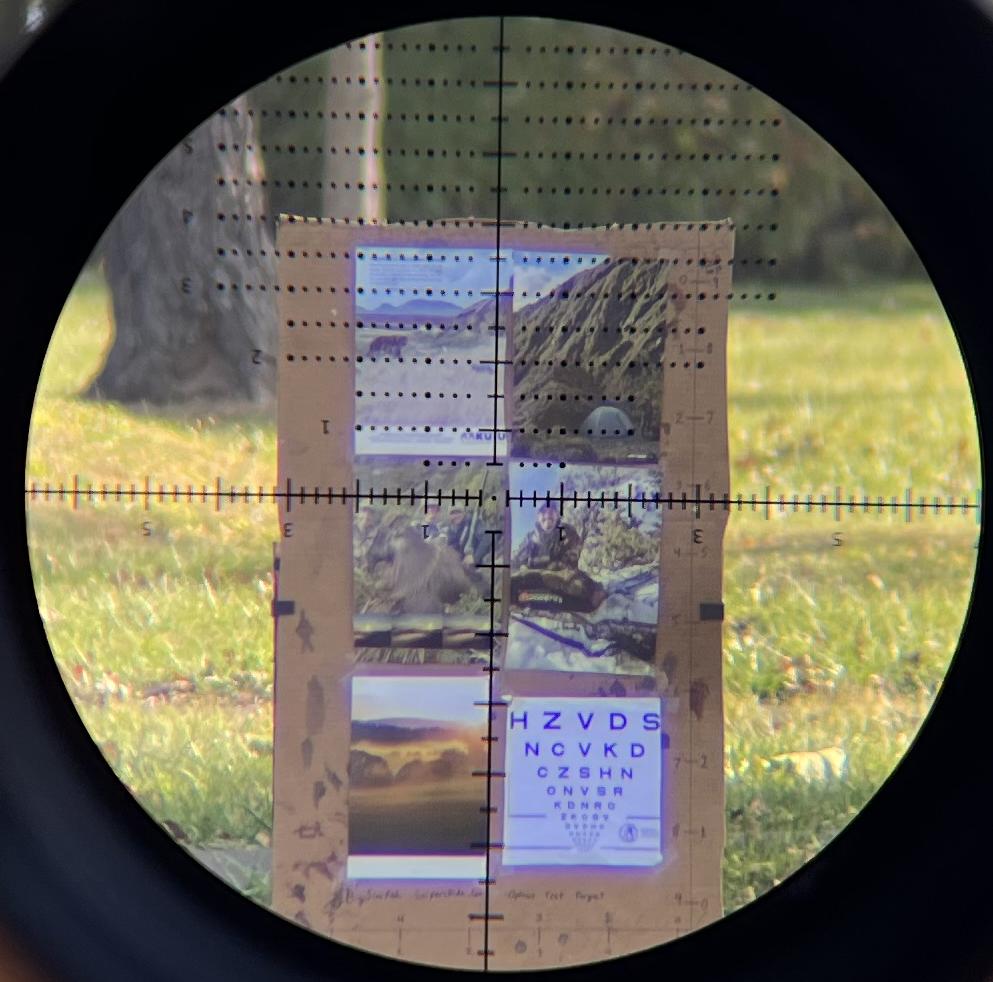
Probably the biggest takeaways from my optical testing of the Sightron SIII PLR FFP were that I found myself comparing it more to the ~$2k scopes than the ~$1k scopes, and that the optical design’s background slants it’s strongest aspects of performance towards fixed distance target use. Its weaker suits are the effect of a smaller FOV when looking for multiple targets and DOF when trying to catch trace or engage multiple targets at different distances without parallax adjustment in between.
Mechanical Testing:
Most scopes have some deviation from perfect adjustment magnitude, though they are doing far better now than just a few years ago. This adjustment magnitude error will vary from example to example within the same model of scope. This is because it is not a product of design errors, but rather variances introduced within manufacturing and, particularly, assembly. So, the performance of my test samples is a piece of information with only limited value due to representing only one example. Often, we measure adjustment magnitude error as a percentage such that a scope whose reticle moves 10.1 mils when adjusted 10.0 mils tracks at 101% and one whose reticle moves 9.9 mils when 10.0 is dialed tracks at 99%. Frank has helpfully compiled a list of adjustment deviation of all scopes he has tested in class that can give you an idea of how often, and by how much, adjustment magnitude deviates from ideal.
One of the points of emphasis Sightron made to me on the PLR was their focus on improving standards on adjustment magnitude to fit with the type of shooting people do with this type of scope. That is to say, dialing lots of drop.
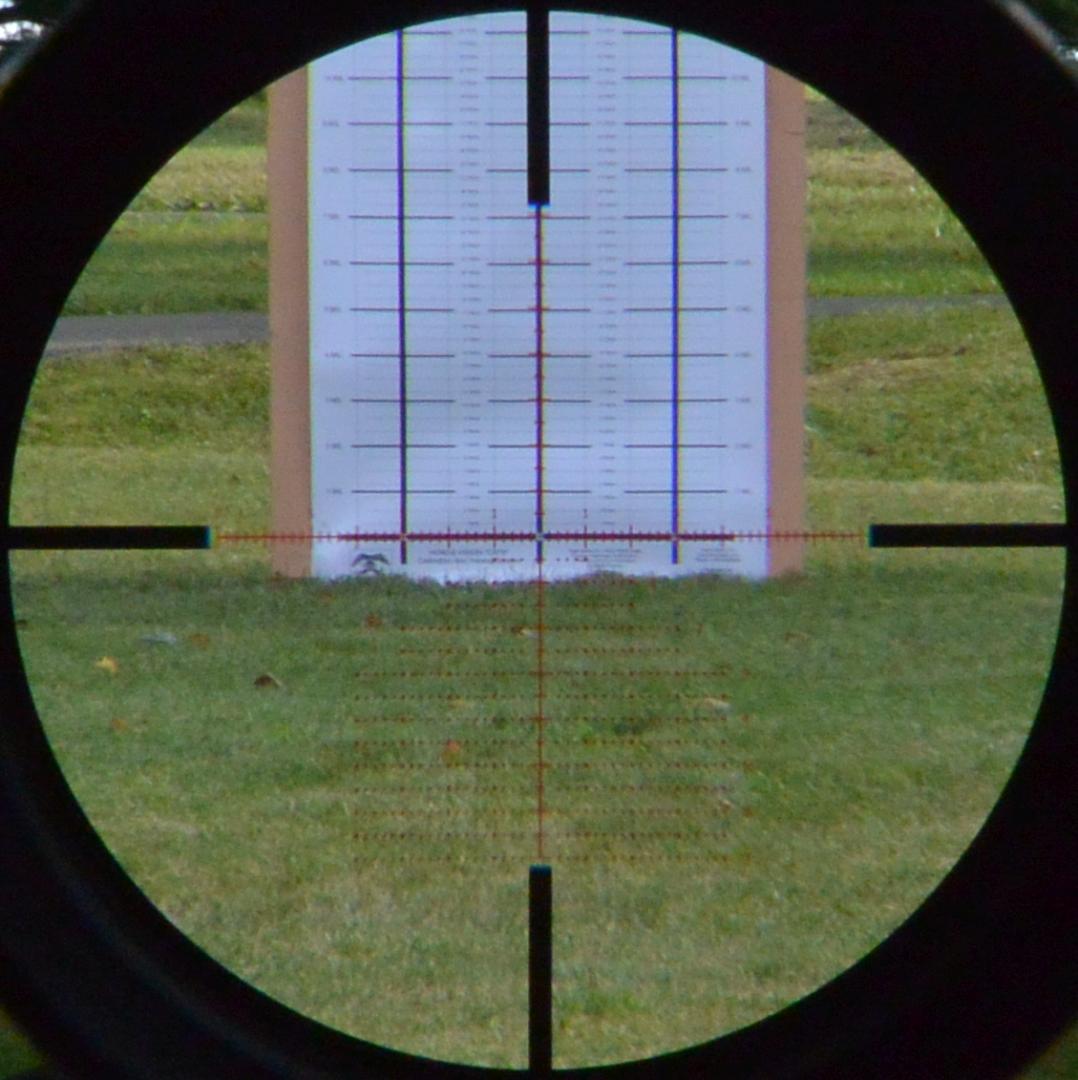
Indeed, my example suggests they have tightened things up a good deal. From center, the PLR tracked up 13 mils with less than .1mil deviation from ideal. From center, it tracked down 13.5 mils, also with less than .1mil deviation. Spec on the PLR is 23.3mils travel, so the 26.5 I found shows that spec to be pretty conservative. Knob travel and actual travel stopped at the same point so you’re not getting any ghost turret movement. The PLR’s windage also tracked within .1mil left (13.0) and right (13.3.) You may have noticed here that there is no windage travel stop at a half a revolution going right and left. You can use the full windage range on the SIII PLR. As such, I tested to see if you could tube out the erector at the edges of the adjustment range. It is possible, but only just barely. At full elevation travel, you will “tube out” (start to see vertical shift when you adjust horizontally and vice-versa because the erector has hit the tube) when you pass 10 mils either way from center. This is a pretty extreme set of scenarios, being both fully elevation maxed and close to full on windage. You are unlikely to have this issue in normal use because of how far you have to go to hit tube, but it’s good to know of the limitations just in case.
The other mechanical controls were likewise on point. There was no PoI shift with parallax, power, or diopter. Looks to me like Sightron has not just produced a new elevation knob that is full featured and has great feel, but also one with better QC on adjustment magnitude.
Summary and Conclusion:
Given that the SIII PLR FFP represents a scope I have been lobbying Sightron for years to make, it should come as no surprise that I generally like it. First off, by dint of its light weight (28oz) and close focus, it has a lot of versatility. It fits the long range .22lr bill as well as the long range hunting bill, in addition to working as a steel banger.
Sightron really surprised me on this PLR with how good the adjustments feel. Frankly, they feel better than anything I’ve tested in the ~$2k range. They are perhaps the second or third best I’ve ever felt at any price, and I have tried near every scope on the market. I was also happy to see the adjustment magnitude tracked spot. Sightron needs to tighten up the QC some on reticle alignment, though: 1% cant is too much. As for the reticle, its busyness and mixed graduation widths kept it from being a favorite for me, but it’s serviceable and I do like that the illumination lights the whole graduated section.
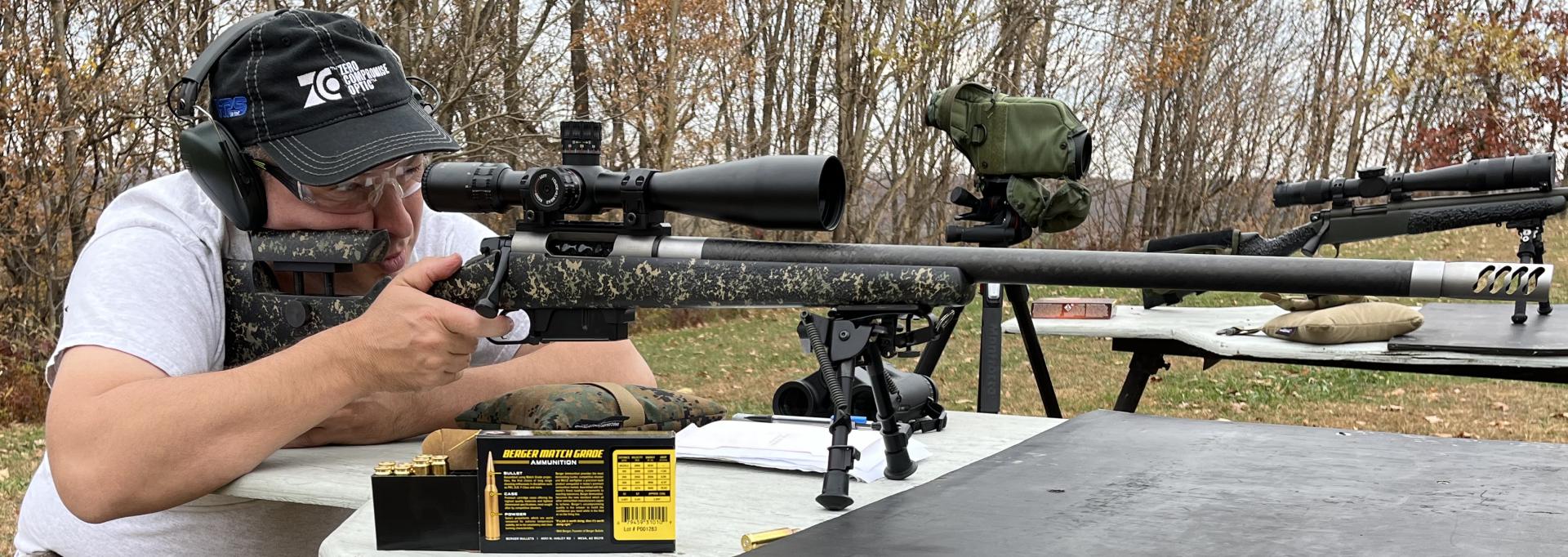
Optically, the SIII PLR shows its heritage as an optical design created for F-class use. It excels at the things those shooters care most about. Its stray light handling is excellent and its resolution is close to on-par with $2k scopes. It is quite comfortable to be behind for extended periods with no eye strain. In areas F-class shooters have little interest in, particularly depth of field and field of view, the design is less impressive. Overall though, I would judge its optical performance closer to a $2k scope than a $1k one.
Indeed, the whole package strikes me as more $2k than $1k. This is true from the extras included in the box (scope caps, lens cloth, and a sunshade), to the high quality fit and finish – even on parts not visible such as under the caps, to the Japanese manufacturing location, to the optical performance, and finally the exceptional feel of the adjustments.
I should note that at the time of this writing, the Sightron SIII PLR 6-24×50 ZS FFP IL #28001 is on sale (ends Jan 1, 2023) for $1,120 instead of the normal $1,470.
Your Pro and Con Breakdown:
Pros:
– Lighter than most competing scopes at 28oz
– The new 10mil / turn zero stop knobs feel great
– Close 20m focus capability for rimfire
– Comes with flip caps and a sunshade
– Better than class average optical performance with particularly good resolution and stray light handling
– Excellent fit and finish
– Unique styling
– Lifetime warranty and made in Japan
Cons:
– Small field of view and very shallow depth of field will be sub-optimal for timed competitions
– Reticle on test sample was canted 1degree. QC on this needs to improve

